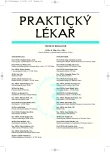Combined chelation treatment in patients with myelodysplastic syndrome and hereditary hemochromatosis – a case study
Authors:
J. Vondráková 1; J. Procházková 1; K. Indrák 1; L. Kučerová 2
Authors‘ workplace:
Hemato-onkologická klinika Fakultní nemocnice
a Lékařská fakulta Univerzity Palackého, Olomouc
Přednosta: prof. MUDr. Karel Indrák, DrSc.
; Ústav patologie FN a LF UP, Olomouc
Přednosta: doc. MUDr. Martin Tichý, CSc.
2
Published in:
Prakt. Lék. 2008; 88(3): 166-169
Category:
Case Report
Overview
There is currently great interest in the diagnosis and treatment of iron overload syndromes. These syndromes are classified as primary (hereditary), for example hereditary hemochromatosis, or secondary (acquired), for example transfusional iron overload. An imbalance between iron uptake and iron elimination leads to its accumulation in the body and the toxic effect of iron overload causes tissue damage (heart, liver, endocrine organs) and can lead to end-organ failure. Therefore, research has focused on means of preventing iron-related morbidity and mortality. Therapeutic management of hereditary hemochromatosis involves venesection, while for transfusion iron overload, iron chelation therapy is useful (deferoxamine, deferiprone or deferasirox) mainly given as monotherapy. We report a complicated case of a patient with hereditary hemochromatosis and simultaneous myelodysplastic syndrome, when venesection was not indicated. In this situation it was necessary to solve anemia and systemic iron overload (hepatopathy, cardiomyopathy, diabetes mellitus) at the same time. This case report demonstrates that combined chelation therapy with deferoxamine and deferiprone was successful, improved patient quality of life and was performed completely in the outpatient clinic.
Key words:
myelodysplastic syndrome, hemochromatosis, iron overload, combined chelation therapy.
Sources
1. Anderson, J.G. Mechanisms of iron loading and toxicity. Am. J. Hematol. 2007, 82, p. 1128–1131.
2. Brissot, P. Diagnosis and current treatments for primary iron overload. Am. J. Hematol. 2007, 82, p. 1140-1141.
3. Brissot, P., de Bels, F. Current approaches to the management of hemochromatosis. Hematology 2006, ASH Education Program Book, p 36 – 41, ISSN 1520 – 4383, dostupný též na http://asheducationbook.hematologylibrary.org/content/vol2006/issue1/.
4. Cohen, A.R. New advances in iron chelation therapy. Hematology 2006, ASH Education Program Book, p. 42-47.
5. Čermák, J. Některé nové poznatky v diagnostice a léčbě stavů s přetížením železem. Transfuze a Hematologie dnes 2006, 12, 3, s. 140-145.
6. Čimburová, M., Půtová, I., Provazníková, H. Hereditární hemochromatóza. Hygiena 2002, 47, 1, s. 41-48.
7. Gattermann, N., Porter, J., Lopes, L.F., Seymour, J. Iron overload in myelodysplastic syndromes. Hematology/oncology clinics 2005; 19(Suppl 1), p. 18-25.
8. Hershko, Ch. Iron loading and its clinical implications. Am. J. Hematol. 2007, 82, p. 1147 -1148.
9. Nearman, Z.P., Szpurka, H., Serio, B. et al. Hemochromatosis-associated gene mutations in patients with myelodysplastic syndromes with refraktory anemia with ringed sideroblasts. Am. J. Hematol. 2007, 82, p. 1076-1079.
10. Pietrangelo, A. Iron chelation beyond transfusion iron overload Am. J. Hematol. 2007, 82, p. 1142–1146.
11. Porter, J.B. Concepts and goals in the management of transfusional iron overload. Am. J. Hematol. 2007, 82, p 1136-1139.
12. Půtová, I., Čimburová, M., Cieslarová, B. et al. Mutace genu HFE u nemocných s hereditární hemochromatózou a dalšími chorobami s akumulací železa v játrech. Čes. a slov. Gastroenter. a Hepatol. 2002, 56, 6, s. 214-219.
13. Wood, J.C. Diagnosis and management of transfusion iron overload. The role of imaging. Am. J. Hematol. 2007, 82, p 1132-1135, dostupný také na www.interscience.wiley.com.
Labels
General practitioner for children and adolescents General practitioner for adultsArticle was published in
General Practitioner

2008 Issue 3
- Memantine in Dementia Therapy – Current Findings and Possible Future Applications
- What Effect Can Be Expected from Limosilactobacillus reuteri in Mucositis and Peri-Implantitis?
- Metamizole at a Glance and in Practice – Effective Non-Opioid Analgesic for All Ages
- Spasmolytic Effect of Metamizole
Most read in this issue
- Genitourinary tuberculosis – current state
- The convergence between neurological and psychogenic etiopathogenesis and the possibilities of psychotherapy.
- The importance of oral hygiene in the prevention of plaque induced oral cavity diseases
- Combined chelation treatment in patients with myelodysplastic syndrome and hereditary hemochromatosis – a case study
